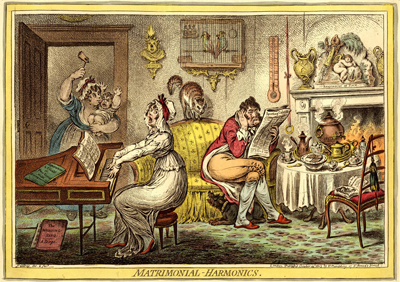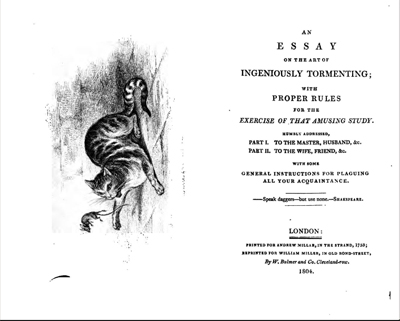Matrimonial Harmonics
This is the second of two contrasting prints with a distinctly musical theme showing a well-to-do couple before and after marriage. As in Harmony Before Matrimony the contrast begins with the very different body language of the pair in the two prints. But it is mostly elaborated by the objects in the room, each of which provides a commentary on the couples' relationship.

© Trustees of the British Museum
What was once a harmonious marriage has now become one full of noise and discord. Instead of leaning in towards one another, and making music together, the husband and wife are engaged in completely separate activities: she plays the pianoforte; he reads the Sporting Calendar. The space between them, instead of being occupied with a book of Ovid's poems, now includes a barking dog, a screeching cat, and a pair of squawking birds who, like the human couple, have new offspring to contend with. And to add to the din, the couple's bawling baby is being brought into the room by a nursemaid who tries to distract the child with a clacking noisemaker.
The allusions to Cupid and Hymen which were largely positive in Harmony Before Matrimony are now distinctly negative. The bust of Hymen, who now resembles the husband, looks like he's lost his nose in a brawl. And above the mantel, Cupid is asleep or dead, his arrows and torch turned upside down. Next to him a vase embossed with the bow of Cupid and torch of Hymen is capped with handles representing snakes hissing at one another. A gauge on the wall registers the psychic temperature in the room—frosty almost to the point of freezing.
Unlike the "Duets de l'Amour" (Love Duets) the couple played together in the earlier print, the music books on or near the piano suggest a marriage in trouble. They include: (ominously) "The Wedding Ring - a Dirge" and "Separation a Finale for Two Voices with Accompaniment." The wife's current selection which includes the words "Torture Fiery Rage \ Despair I cannot can not bear" is being played (as prescribed) "Forté." And by her backward glance and the open book upon her vacant chair, her goal is not harmony, but further discord. She is purposely trying to torment her spouse. And with his hand over his ear, his mouth stuffed with muffins, he is just as purposely trying to ignore her and the entire raucous situation. But the fiery hearth, the hissing urn, and steaming coffee pot and cup, all on his side of the room, suggest a situation that may be about to boil over.
Unlike series by Hogarth and Collett, however, there is little, if any, overt moralism implied in Gillray's print. There is neither Rake nor Harlot here; simply two people who thought they had fallen in love who have now fallen out of it. If there is a Hogarthian antecedent for this print, it is more likely The Enraged Musician which, like Matrimonial Harmonics, aims at portraying a convincing visual image of cacaphony.
NOTE: As you can see below, "The Art of Tormenting" appearing on the wife's chair is based upon a real publication: An Essay on the Art of Ingeniously Tormenting by Jane Collier originally published as a satire in 1753. Gillray was familiar with it because he etched the Frontispiece to the 1804 edition. But apart from the title, there doesn't appear to have been any influence on Gillray's treatment of Matrimonial Harmonics.

© Internet Archive
PREV: Harmony Before Matrimony
Sources and Reading
- Commentary from the British Museum on Matrimonial Harmonics.
- Draper Hill, The Satirical Etchings of James Gillray, 1976, #87
- "An Essay on the Art of Ingeniously Tormenting," Wikipedia
- An Essay on the Art of Ingeniously Tormenting London, 1804.
- "The Enraged Musician," Wikipedia
- Thomas Wright and R.H. Evans, Historical and Descriptive Account of the Caricatures of James Gillray #539.
- Thomas Wright and Joseph Grego, The Works of James Gillray, the Caricaturist; With the History of His Life and Times, pp. 324-6.
Comments & Corrections
NOTE: Comments and/or corrections are always appreciated. To make that easier, I have included a form below that you can use. I promise never to share any of the info provided without your express permission.